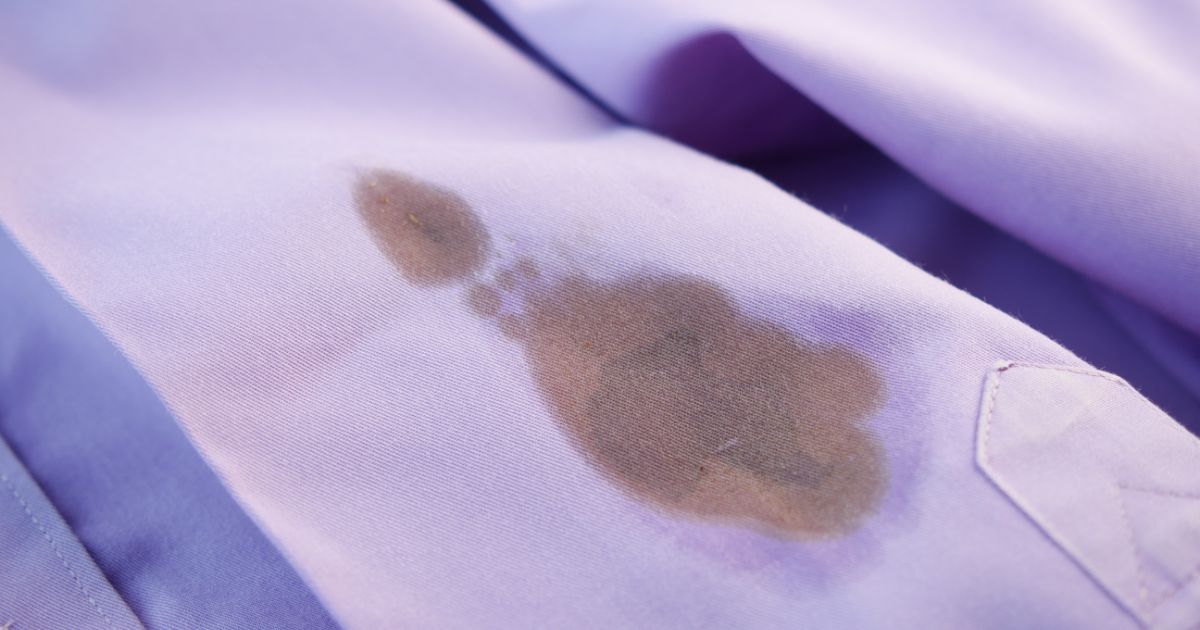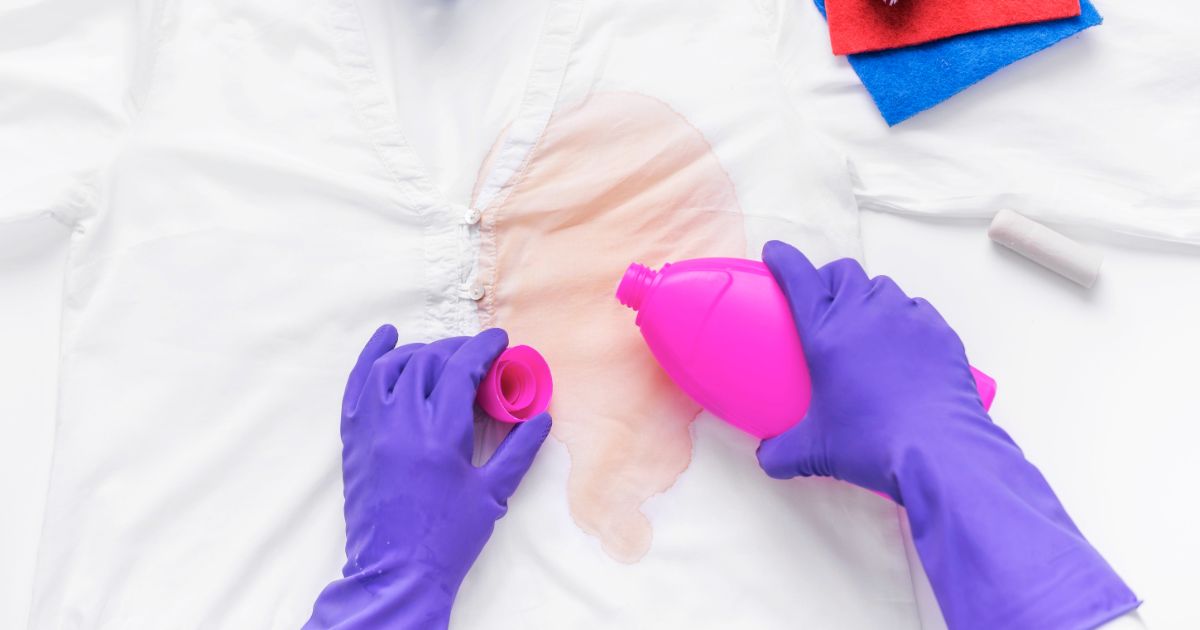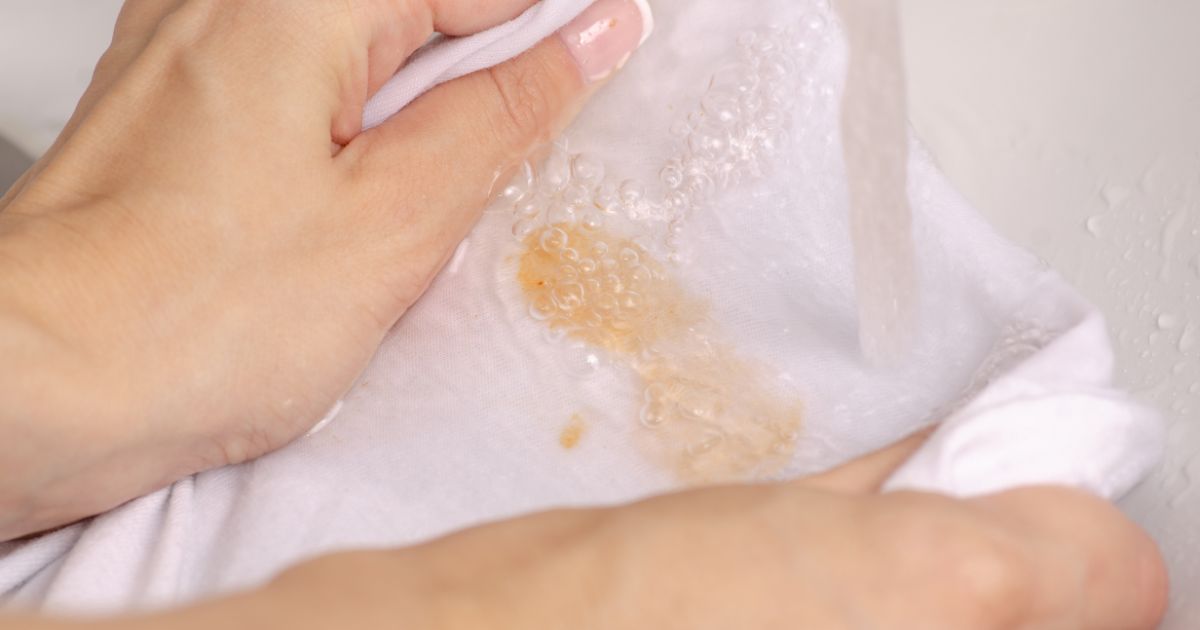Imagine this: You go into the kitchen to make lunch or even a quick salad for dinner. One minute, you’re adding the ingredients into your pans or bowls, and the other, you notice something — a stain on your shirt! We’ve all been there — such accidents always happen in the kitchen.
When this happens, panic sets in as you try to think about what you can do to remove that stain as quickly as possible without letting it set in. But how to remove cooking oil stains from clothes – do you grab the dish soap or do you need to run to the store and find a commercial stain cleaner? That’s exactly what we are here to help you with!
We’ve dealt with many stains over the years, but something good has come from that! We’ve tried numerous ingredients and a handful of techniques to clean them. We’ve selected the most effective cleaners and techniques to remove grease stains quickly and easily, so keep reading if you want to learn all about them!
You’ve Stained Your Clothes — What Now?

It’s always best to catch grease stains early. Don’t leave stains to dry or let them transfer to other garments they come in contact with.
Anyone who knows their way around the kitchen will generally recommend not cooking in new clothes or clothes you wear to go out. Try wearing something that you won’t mind staining. If that’s not possible, wear a kitchen apron to protect your clothes as much as possible.
If you still get a stubborn stain, treat it with a few items you likely have at home. Do that as soon as possible and repeat it as many times as needed to remove the stain completely. Then, proceed to wash and dry the garment as usual.
Why are Cooking Oil Stains Difficult to Remove?
Everyone always talks about how oil stains are nearly impossible to remove completely, especially if you leave them on your clothes for too long. This is because oil and water don’t mix. Oil repels water, so a washing cycle that uses water will not do much for oil stains. Instead, the oil will quickly seep into the clothing fibers and stay there until properly treated.
If you want to prevent a grease stain from setting, you will need to start pre-treating it as soon as possible.
What Household Items to Use on Grease Stains?
The type of cleaner you use on your stains will depend on the type of stains you have. When it comes to greasy stains from any type of cooking oil, you can rely on a few household items to help you remove them quickly.
Here are the items we recommend you try first:
- Dish Soap: Liquid dish soap breaks down the grease on your pans, pots, plates, and everything else. Similarly, you can use it to break down grease on your clothes. The special enzymes in dish soap easily seep into the material and cause the grease to break down.
- Liquid Detergent: Liquid laundry detergent acts similarly to liquid dish soap, so it can quickly get into the grease and break it down, even eliminating it. While you can use it for pre-treating stains, we recommend going in with another item first and then using the detergent when machine washing the garment.
- Baking Soda: Baking soda is a go-to cleaner for many things, including greasy stains. Lather it on the grease-stained garment and see how it absorbs the grease. Similarly, its abrasive nature will allow you to rub it into the stain and remove all remaining oils.
- Talcum Powder: Talcum or baby powder is also helpful for greasy stains because of its absorbent nature. Like baking soda, you can lather Talcum powder on a garment to remove the grease stain quickly and without damaging the fabric.
- Rubbing Alcohol: Rubbing alcohol has proven to be effective in dissolving grease and other types of oils. However, while effective, it can damage delicate fabrics, so consider the type of garment you have before using rubbing alcohol as a stain remover.
- WD-40: WD-40 is something you may have around your home or in your car, but you can also use it in the kitchen if you need to remove stains. Be careful when applying it to the garment, as you don’t want it to damage the colors or material.
When Should You Try Commercial Stain Removers?

In addition to the household items mentioned above, specialized commercial stain removers are available. You can try these, but you need to remember a few things first:
- Always read the instructions on the care label. Learn which stains this remover is best for and what materials you can use it on. If the remover contains harsh chemicals but offers limited information on usability, it’s best not to risk damaging your garment.
- If you discover a stain remover that you want to use, we recommend testing it on a small piece of fabric first. That way, you can see how the remover reacts with your garment and whether it’s safe to use.
- If you find the stain remover is safe for your type of garment, use it on the stain, but only for the recommended amount of time. Leaving it on too long or letting it dry along with the stain can only damage the fabric. Follow instructions exactly as the manufacturer recommends.
- After treating a grease stain with a commercial stain remover, wash and dry your garment as you normally would. Repeat this process if needed to remove any remaining grease.
While commercial stain removers are a great way to quickly remove grease stains, we recommend using an eco-friendly cleaner first and avoiding using harsh chemicals on your clothes. If your DIY efforts don’t work and you’re not sure what to do next, try a commercial stain remover suitable for your type of fabric.
How to Remove Cooking Oil Stains from Clothes: Step-by-Step Guide

Now that we’ve explored the different cleaning solutions you can use to treat your oily stains, it’s time that we walk you through the entire cleaning process to demonstrate what to do to make your clothes stain-free!
There are many ways to go about this process, and you may find various techniques and solutions recommended online, but this is the tried-and-tested method that we swear by!
Here is our step-by-step guide to removing cooking oil stains from clothes:
Blot excess cooking oil
The first step to removing grease stains from clothes is to blot as much of the cooking oil as possible, especially if you see it form a large stain on your garment.
For this to be effective, lay your garment on a flat surface. You can put a piece of cardboard between the layers of the garment to prevent the oil from seeping into the other parts. Then, take a paper towel or a clean cloth and blot away as much of the oil as possible. There’s no need to use any cleaning solution at this point, just ensure you prepare the garment well for the next step.
Use absorbent powder
Baking soda, talcum powder, and baby powder are examples of good absorbents you can use to treat cooking oil stains – use whichever option you have at home. Put it directly on the stain, and don’t be afraid to really lather it on. The more absorbent powder you use, the easier it will be for the oil to be absorbed, leaving you with a canvas that will be easier to treat later on.
Repeat this process several times, as needed. Once the powder becomes greasy, remove it and put some more. Repeat this until you get nearly clean powder.
Pre-treat the stain
Now, for the fun part — cleaning the stain.
Select the type of cleaner you want to use – whether it’s dish soap, laundry detergent, or even a commercial cleaner. For really oily stains, don’t be afraid to put a lot of dishwashing liquid on the garment. If you use a chemical cleaner or WD-40, use cotton swabs to put the cleaner directly on the stain and avoid damaging the rest of the material.
If the stain is small, keep dishwashing or laundry detergents on for 30 to 60 minutes. Leave the solution on overnight if you have a larger area to clean or a persistent stain to remove. When using commercial cleaners, leave them on only as long as the manufacturer recommends.
Warm water rinse
After spot-cleaning the stain, use hot water to rinse the area and check whether the stain has been completely removed. Hot water will dissolve any remaining oils. If you see that there is still a stain, repeat the previous step and this one to ensure everything comes out.
Machine wash the garment
After ensuring there’s no longer a stain on your garment, put it in the washing machine. Set it to the warmest water temperature setting and use a suitable laundry detergent. Cold water temperatures will not be as effective in this cleaning process.
Check the stain
After washing the garment, inspect it thoroughly to ensure it is free of oily stains. Do this step before letting the garment dry, as drying it — especially in a dryer — can make oily stains set in more easily. Inspect the garment for remaining stains and treat them accordingly and then repeat the washing process.
FAQs
How do you get dried oil stains out of clothes?
You can get dried oil stains out of clothes if you treat them with harsher cleaners such as a mixture of baking soda and WD-40 or even a commercial stain remover. Then, machine wash the clothes with a special liquid detergent on a wash cycle that includes the hottest temperature setting.
Does vinegar remove oil stains from clothes?
White vinegar is an effective household item for cleaning oily stains from clothes. The acid in it helps break down grease, making it easier to remove. While practical, you should only use it in small amounts to prevent damaging the garment fibers.
Should I wash the garment immediately after treating an oil stain?
Absolutely! If you have a stained garment and go through the stain removal process, you can then throw that garment into the washing machine to ensure all the cleaning solutions come off and your fabric stays intact. However, do not let the garment dry until you remove all the oil from the fabric.
Final Thoughts
Cooking oil, whether vegetable or sunflower oil, olive oil, or something entirely different, can quickly stain even the most stain-repellent fibers. Once that stain forms, only quick and effective action will help remove it from your garment.
Cleaning these oily stains doesn’t always require a specialized cleaner — you can even use a regular household item that you would use to clean your kitchen or something entirely different. Resort to using harsher cleaners only when none of the DIY methods work, and always choose cleaners that are suitable for the clothing material and type of stain.
If you want any more help learning how to remove cooking oil stains from clothes, do not hesitate to contact Cook Room Kitchen. We have the best tips and tricks for cleaning various stains, so contact us for any additional tips or concerns!





